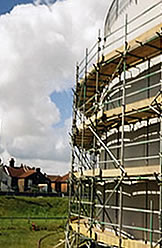In the dynamic realm of industrial construction, sustainable approaches are growing progressively essential. Within these practices, sustainable scaffold systems are taking center stage. As business developments expand in scale and intricacy, the need for efficient and reliable scaffold is paramount. Comprehending what commercial scaffolding is and why is crucial not only helps protect employees but also adds to a greener building process.
Possessing various kinds of scaffold available, every tailored for specific tasks, it is essential for contractors to choose carefully. Improving job site protection and adhering to rigorous rules are important components of any business endeavor. This article examines the various forms of scaffolding utilized in the sector, emphasizes security compliance issues, and looks into the significance of scaffolding in today's construction. Ranging from high-rise developments to extensive remodels, we will discover how green scaffold methods can support both the environment and the outcome of commercial building projects.
Comprehending Industrial Frameworks
Commercial scaffolding is a short-term framework employed to support laborers and materials during the building, renovation, or servicing of commercial structures. It provides a secure working space at different heights, allowing contractors to gain entry to inaccessible areas for activities such as decorating, drywall placement, or framework fixes. Its importance cannot be underestimated, as it plays a vital role in guaranteeing both efficiency and safety on work sites.
The kinds of scaffolding employed in business work change based on the specific requirements of the job. Conventional frame frameworks, unitized scaffolding, and designed scaffolding are popular choices, each presenting special advantages in terms of flexibility, durability, and simplicity of assembly. Selecting the correct scaffolding solution is crucial for complying with safety regulations, withstanding the capacity needs of the project, and fitting the particular layout of the structure.
In also enhancing entry, industrial frameworks increases job site security by supplying employees with firm grounds and handrails to stop incidents. Correctly constructed scaffolding minimizes the likelihood of incidents, and observance with standards such as those established by the Occupational Safety and Health Administration is crucial. Organizations must perform routine safety inspections and provide extensive education for their workers to guarantee all workers grasp the risks associated with frameworks and how to reduce them effectively.

Protection and Regulations in Scaffold Systems
Guaranteeing protection and adherence in scaffold systems is paramount for safeguarding workers and preserving the safety of a construction site. https://www.scaffolders-kent.uk/best-commercial-scaffolding-in-kent/ and Health Administration has set forth particular regulations that govern scaffolding operations, mandating checks, training, and adherence to safety protocols. Following these regulations with these guidelines not only aids to avoid incidents but also reduces legal risks for businesses involved in commercial construction. It is essential that all crew members understand these regulations to cultivate a culture of security on the job site.
Furthermore, conducting comprehensive safety inspections is a vital step in the scaffolding process. Before any work starts, scaffolding must be inspected by a qualified individual to ensure its structural integrity and adherence to safety regulations. Regular inspections should be conducted during the duration of the project to identify wear and tear, loose components, or any potential risks that could jeopardize worker safety. These checks should be documented and reviewed to ensure compliance with both federal and state regulations.
Training expectations for scaffolding crews play a vital role in ensuring worker protection on site. All employees must receive proper instruction on the use of scaffold gear, identifying hazards, and emergency procedures. Ongoing education and updates help keep safety protocols at the forefront of crew operations. When employees are knowledgeable and prepared with the right information, the chances of accidents diminishes greatly, creating a safer workspace for all involved in the commercial construction project.
Selecting the Right Scaffolding Solutions
Determining the right scaffolding solution for a industrial project can greatly impact security, efficiency, and overall project success. Begin by analyzing the specific demands of your project, including the elevation, type of work being performed, and the surroundings in which the scaffolding will be used. Understanding these factors will help you decide whether a modular system, tube and clamp, or system scaffolding meets your needs best. Each type offers distinct benefits, so think about the extent of work and site logistics.
It is essential to assess the weight-bearing capacity and stability of the scaffolding system you choose. For example, aluminum scaffolding is easy to transport and easy to set up, making it perfect for projects requiring quick assembly and mobility. Nevertheless, for more substantial equipment or loads, you may require a more sturdy steel scaffolding solution. Talking to a scaffolding expert can provide insights into the best components and plans to ensure security and adherence with industry regulations.
Additionally, consider the simplicity of access and the potential for tailoring in your scaffolding setup. Custom scaffolding solutions can be tailored to fit unique architectural features or site limitations. When you prioritize accessibility and flexibility in design, you build a safer working environment for your crew while enhancing overall project productivity. Ultimately, making educated decisions about scaffolding solutions will lead to more successful project outcomes.
